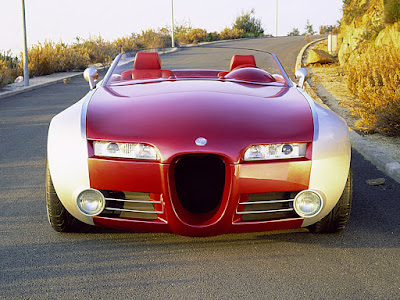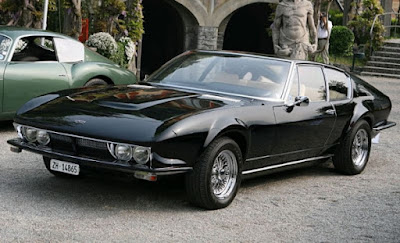Unique ONES - The automotive world is often filled with surprises, where unique creations from all corners of the globe can capture the attention of enthusiasts. Whether from traditional manufacturers or independent designers, each new model brings its own innovation, pushing the boundaries of what is possible. One such remarkable creation comes from Russia, a country not commonly associated with the production of sports cars. However, the Cardi Curara, a standout two-seater sports car, demonstrates that the unexpected can sometimes deliver extraordinary results.
 |
| The Cardi Curara is a standout two-seater sports car, demonstrates that the unexpected can sometimes deliver extraordinary results. (Picture from: Carstyling.ru) |
 Russia, a land known for its challenging weather conditions and vast terrains, might not seem like the ideal birthplace for a sleek, retro-inspired sports car. Yet, the Cardi Curara defies expectations. Built by Moscow-based Cardi Design Studio, this car takes inspiration from classic Italian barchettas, blending that nostalgic style with a modern twist. Finished in a striking two-tone red and silver color scheme, the Curara reflects the elegance and racing spirit often associated with European sports cars.
Russia, a land known for its challenging weather conditions and vast terrains, might not seem like the ideal birthplace for a sleek, retro-inspired sports car. Yet, the Cardi Curara defies expectations. Built by Moscow-based Cardi Design Studio, this car takes inspiration from classic Italian barchettas, blending that nostalgic style with a modern twist. Finished in a striking two-tone red and silver color scheme, the Curara reflects the elegance and racing spirit often associated with European sports cars. |
| Finished in a striking two-tone red and silver color scheme, the Cardi Curara reflects the elegance and racing spirit often associated with European sports cars. (Picture from: Carstyling.ru) |
Barchetta-style vehicles have always held a special place in the hearts of automotive enthusiasts, particularly those who enjoy spirited weekend drives on scenic roads. The Cardi Curara follows in this tradition, offering a driving experience that is as exhilarating as it is refined. Its design is centered around simplicity and performance. A long, sweeping hood, a compact cabin positioned toward the rear, and short front and extended rear overhangs give the car a distinct silhouette, making it instantly recognizable on the road.
 |
| The Cardi Curara features a long, sweeping hood, a compact cabin positioned toward the rear, and short front and extended rear overhangs give the car a distinct silhouette, making it instantly recognizable on the road. (Picture from: Carstyling.ru) |
The journey of Cardi Design Studio began in 1995, when the company introduced its first creation, the Body roadster. Since then, Cardi has continued to produce unique and limited-run models, each more ambitious than the last. The Curara, first unveiled at the Paris Motor Show in 1998, marks one of the studio’s most celebrated achievements. Its neoclassical design, combined with advanced technical features, sets it apart from other vehicles in its class.
 |
| The Cardi Curara impresses with its minimalist yet luxurious interior, showcasing Cardi’s meticulous attention to detail through the use of English Connolly leather and polished metal. (Picture from: Carstyling.ru) |
One of the most striking features of the Cardi Curara is its minimalist yet luxurious interior. Cardi’s attention to detail is evident in the choice of materials, with English Connolly leather and polished metal creating an atmosphere of understated elegance. The car's cabin is simple but refined, with a McIntosh Hi-End sound system integrated into the central console, providing both functionality and style. Every element inside the vehicle reflects Cardi’s dedication to craftsmanship.
 |
| The Cardi Curara's cabin is simple but refined, with a McIntosh Hi-End sound system integrated into the central console, providing both functionality and style. (Picture from: Carstyling.ru) |
The Curara’s design was met with widespread acclaim in Paris. Not only did the car capture the attention of industry experts, but it also received glowing praise from automotive media. The French magazine Automobiles Classiques featured the Curara, commending its combination of Russian ingenuity and European styling. The reception underscored Cardi’s growing reputation as a studio capable of producing vehicles that could stand alongside established European brands.
 |
| Beneath its elegant exterior, the Cardi Curara houses a powerful BMW V12 engine that delivers an impressive 300 horsepower. (Picture from: Carstyling.ru) |
Beneath its elegant exterior, the Cardi Curara is a performance machine. At its heart is a powerful BMW V12 engine, capable of producing an impressive 300 horsepower. This engine, paired with a sports suspension system developed from the ground up, ensures that the Curara is not just a showpiece but also a car built for the road. Ventilated brakes and lightweight Antera alloy wheels complete the package, contributing to its exceptional handling and responsiveness.
 |
| The Cardi Curara also featured with a new suspension system with horizontal shock absorbers and updated rear lighting will further improve the vehicle’s performance and compliance with road regulations. (Picture from: Carstyling.ru) |
While the prototype displayed in Paris wowed audiences, Cardi did not rest on its laurels. The studio continued to refine the design, preparing the Curara for limited production. The planned upgrades include a carbon fiber body using advanced sandwich panels, enhancing both strength and weight reduction. A new suspension system with horizontal shock absorbers and updated rear lighting will further improve the vehicle’s performance and compliance with road regulations.
 As Cardi continues to work on bringing the Curara to a wider audience, it remains a testament to what is possible when passion and creativity meet technical expertise. The Curara is more than just a car; it is a symbol of Russia’s emerging presence in the global automotive scene. In a world where innovation often comes from the most unexpected places, the Cardi Curara proves that even in challenging environments, automotive excellence can flourish. *** [EKA | FROM VARIOUS SOURCES | CARDI.RU | CLASSICDRIVER | STORY-CARS | CARSTYLING.RU ]
As Cardi continues to work on bringing the Curara to a wider audience, it remains a testament to what is possible when passion and creativity meet technical expertise. The Curara is more than just a car; it is a symbol of Russia’s emerging presence in the global automotive scene. In a world where innovation often comes from the most unexpected places, the Cardi Curara proves that even in challenging environments, automotive excellence can flourish. *** [EKA | FROM VARIOUS SOURCES | CARDI.RU | CLASSICDRIVER | STORY-CARS | CARSTYLING.RU ]Note: This blog can be accessed via your smart phone.






































